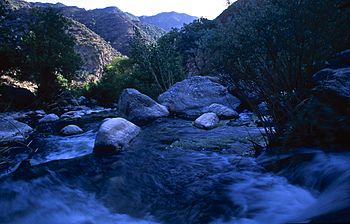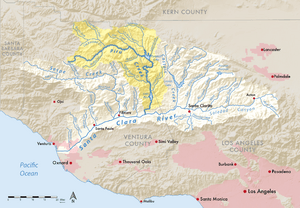Piru Creek facts for kids
Quick facts for kids Piru Creek |
|
|---|---|

Piru Creek
|
|

Map of the Santa Clara River watershed, with the Piru Creek sub-watershed highlighted.
|
|
| Other name(s) | Arroyo de Piruc, Arroyo Piru, Rio Peru |
| Country | United States |
| State | California |
| Region | Ventura County, Los Angeles County |
| City | Piru, California |
| Physical characteristics | |
| Main source | San Emigdio Mountains An unnamed spring, Ventura County, United States 5,200 ft (1,600 m) 34°38′12″N 119°12′11″W / 34.63667°N 119.20306°W |
| River mouth | Santa Clara River Piru, Ventura County 643 ft (196 m) 34°23′56″N 118°47′08″W / 34.39889°N 118.78556°W |
| Length | 71 mi (114 km) |
| Basin features | |
| River system | Santa Clara River |
| Basin size | 497 sq mi (1,290 km2) |
| Tributaries |
|
| Type: | Wild, Recreational |
| Designated: | March 30, 2009 |
Piru Creek is a large stream in California, about 71 miles (114 km) long. It flows through northern Los Angeles County and eastern Ventura County, California. Piru Creek is a major branch, or tributary, of the Santa Clara River. The Santa Clara River is one of the biggest natural river systems in Southern California.
Piru Creek collects water from an area of about 497 square miles (1,290 km2). This makes it the largest tributary of the Santa Clara River based on its watershed size. A watershed is the area of land where all the water drains into a specific river or stream. Most of Piru Creek, especially the part above Lake Piru, is located within the Los Padres National Forest. There are two main reservoirs on Piru Creek: Lake Piru and Pyramid Lake. These reservoirs hold water for local farms and for the California State Water Project, which moves water across the state.
Contents
Journey of Piru Creek: Where Does It Flow?
Piru Creek starts from several small springs. These springs are found on the north side of Pine Mountain Ridge in the Santa Ynez Mountains. This area is part of the Los Padres National Forest.
Upper Piru Creek: From Springs to Canyons
The creek first flows east through a gentle valley. Here, it is joined by Cedar Creek from the right side. After this, Piru Creek turns northeast. It then receives water from Sheep Creek (from the left) and Mutau Creek (from the right). Further along, Lockwood Creek joins from the left near the Sunset campground. The creek then flows east into a deep canyon. Here, the valley walls become much steeper and taller.
Piru Creek and Pyramid Lake
The Smith Fork of Piru Creek flows in from the left. Its source is in the San Emigdio Mountains, about 5 miles (8.0 km) south of Gorman. Piru Creek then turns sharply southeast. It enters the Pyramid Lake reservoir. This lake is held back by Pyramid Dam. Pyramid Lake stores water that comes from the West Branch of the California Aqueduct. This water is used by Ventura County and Los Angeles County. Interstate 5 runs high above the east side of the lake, nearly 1,000 feet (300 m) up.
Lower Piru Creek: Through Gorges and Valleys
Below Pyramid Dam, Piru Creek usually has a steady flow because water is released from the reservoir. It turns south and flows through the Topatopa Mountains. This part is called the Piru Gorge. It follows the old route of Highway 99 and Pyramid Dam Road. The creek forms the border between different parts of the Los Padres National Forest. It also drops over Piru Creek Falls.
The creek continues south through Cherry Canyon to Frenchman's Flat. Here, Osito Creek joins from the left. Piru Creek then turns sharply west into another gorge. It flows south through this gorge, receiving water from Fish Creek (from the right), and then from ephemeral (meaning it flows only after rain) Turtle Creek (right) and Michael Creek (left). Finally, Agua Blanca Creek joins from the right. The creek crosses the border between Los Angeles County and Ventura County five times. It then leaves the Los Padres National Forest. Here, it is held back by Santa Felicia Dam to form Lake Piru, the second reservoir on the creek.
Below Lake Piru, the canyon gets wider. The creek becomes a wide, gravelly wash. It reaches the Santa Clara River Valley near the town of Piru. It flows under State Route 126 before joining the Santa Clara River.
History of Piru Creek and Its People
Thousands of years ago, Native American groups lived along Piru Creek. The Chumash were in the area first. By about 500 CE, the Tataviam people had moved into the area. They took over the land along Piru Creek. It is thought that there were once up to 25 Native American villages along the creek. Eight of these villages have been studied in detail by experts.
Early Explorers and Land Grants
In 1769, Spanish explorer Don Gaspar de Portolá was the first European to travel up Piru Creek. Later, in 1839, the Mexican government gave a large piece of land, about 48,612-acre (19,673 ha), called Rancho San Francisco to Antonio del Valle. In 1853, Ygnacio del Valle created the Rancho Camulos from parts of Rancho San Francisco. This new ranch included areas of Piru Creek and the Santa Clara River valleys.
Mining for Minerals
In 1842, small amounts of gold were found on Placerita Creek, a nearby branch of the Santa Clara River. This discovery brought many prospectors (people looking for valuable minerals) to the area. By the late 1800s, prospectors also found traces of calcite on Piru Creek. This was in Lockwood Valley, near Frazier Mountain, north of where Pyramid Lake is today. A town called Lexington was planned there in 1887, but it was never built.
In the 1880s, a mineral called borax was also mined in the upper Piru Creek area by the Frazier Borate Company. This company started a town called Stauffer in the late 1890s. In 1905, Stauffer even got its own post office. However, the mines closed soon after, and the town began to shrink. It was completely abandoned by 1942. The Russell Borate Mining Company also bought land in the Piru Creek area in 1907. By 1912, the Russell mine was the only one still working. In the end, all the borax mines closed. This was because of competition from larger borax operations in Death Valley.
Fun Activities Along Piru Creek
The Los Padres National Forest surrounds much of Piru Creek. This area offers many fun outdoor activities. You can go hiking, camping, off-roading (driving vehicles on unpaved roads), and rock climbing.
Hiking Adventures
One popular hiking trail follows Piru Creek through the lower part of Piru Gorge. It goes from Frenchman's Flat to where Fish Creek joins. It's possible to continue hiking all the way south from there to Lake Piru. This part of the hike involves a lot of climbing over rocks and wading through water. The entire hike can take more than two days to finish. Be careful, as flooding from Piru Creek can be a danger.
Rafting and Kayaking
In the spring, you can go rafting and kayaking on parts of Piru Creek. This includes the sections from Pyramid Lake to Lake Piru, and from Santa Felicia Dam to the creek's mouth. The first part is about 15-mile (24 km) long and has exciting rapids up to Class IV. This includes a challenging section called Falls Gorge. The second part is calmer, about 4-mile (6.4 km) long, with only Class I-II rapids.
Water is released from the two dams in a controlled way. This helps manage the flow, though they try to make it feel like natural water flow. Because of this, these sections are usually only good for rafting after it has rained. A section of Piru Creek, from about 0.5 miles (0.80 km) downstream of Pyramid Dam to the Los Angeles-Ventura County line, is part of the National Wild and Scenic Rivers System. This means it is protected for its natural beauty and recreational value.
Fishing Opportunities
Piru Creek used to be a place where people could fish all year round. Today, the highest point where fish naturally lay their eggs (spawn) is below Pyramid Dam. There, a concrete culvert (a tunnel for water) next to the old Highway 99 creates a 15-foot (4.6 m) waterfall.
Piru Creek was once a favorite spot for both fly fishing and bait-casting. It had both wild and hatchery-raised rainbow trout, along with largemouth bass. However, the California Department of Fish and Game no longer stocks the creek with trout. Also, because there isn't enough enforcement, too many fish have been taken illegally (poaching). This has reduced both the trout and bass populations.
Some areas are marked as "catch and release" zones. In these spots, you must use barbless, artificial lures and release any fish you catch. These areas are still somewhat active along a three-mile stretch of the creek from Pyramid Dam to Frenchman's Flat. The best time to fish here is from January to April. You can keep a limit of 5 fish per angler in these specific areas. However, a 900-foot (270 m) section from Pyramid Dam to a small bridge downstream is completely closed to all fishing.


